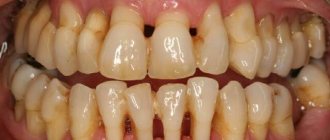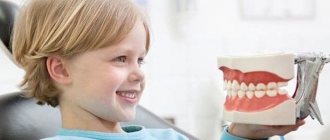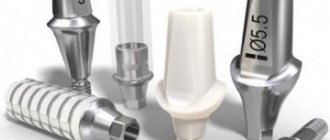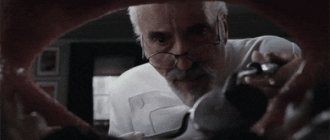Who is the procedure indicated for?
Tooth extraction is done only in the most extreme cases, when treatment is not possible. This rule applies to permanent teeth. In particular, the following situations belong to the indications:
- installation of implants;
- treatment of severe forms of cysts, granulomas, pulpitis, when other methods are ineffective;
- with periodontal disease or periodontitis;
- when installing a braces system or dentures in the case when some teeth interfere with this process;
- removal of a wisdom tooth that grows in the wrong direction or causes certain problems during its growth.
Removal of baby teeth
There are cases when a baby tooth is removed before its physiological replacement with a permanent one occurs. The operation is indicated for the inflammatory process (advanced pulpitis, periodontitis), as well as for deep caries, when there is no chance of restoring the crown.
The difficulty of the procedure is that the enamel of a baby tooth is very thin and can be easily damaged. Therefore, the dentist uses special reduced forceps, the same as for extracting fragments of dental roots.
Main stages
Regardless of the indications, the tooth is removed in several stages:
- examination by a doctor, diagnostic procedures, medical history;
- anesthesia of nearby areas (carried out by injection into the gum of the anesthetic Ultracaine, Ubestezin, or others)
- ligamentotomy (detachment of the tooth itself from the gum);
- application of forceps, their gradual movement to the area under the gum and further fixation;
- tooth dislocation;
- direct removal of the element from the hole;
- inspection and treatment of the hole using antiseptics and other medications;
- suturing (carried out only if there is a large wound surface).
Usually, tooth extraction goes without problems, but in rare cases, some complications of the procedure itself are possible. This may be a root fracture, bleeding, soft tissue injury and other pathologies that are promptly corrected by a doctor.
If we are talking about removing a wisdom tooth that has not yet erupted but is growing incorrectly, then in this case an incision in the gum is necessary to extract it. In such a situation, the wound is quite deep and the gums take a little longer to heal after tooth extraction.
Easy removal
Simple removal is carried out using hand pliers, which consist of cheeks (the closing part for gripping the crown), a lock and handles. There is a special type of forceps for each type of teeth:
- for the upper incisors and canines - straight forceps;
- for all molars and premolars - S-shaped;
- for the lower incisors - forceps curved at right angles with thin cheeks;
- to extract roots - forceps with non-converging jaws.
Operation stages
- Application of forceps to the coronal part.
- Promotion of the cheeks under the gums without injuring the mucous membrane.
- Fixing (closing) the forceps with moderate force so as not to crush the crown.
- Luxation and rotation - rocking and dislocation of the tooth.
- Traction is the removal of the crown from the socket.
The tooth extraction operation takes 10-15 minutes. For pain relief, local anesthesia is used (an injection of Lidocaine, Articaine or Ultracaine D-S). However, if the patient experiences panic fear before manipulation, or when several units need to be removed at once, the procedure is performed under general anesthesia.
What to do after tooth extraction?
To prevent complications, immediately after tooth extraction, prophylaxis must be carried out several hours later. It consists of the following activities:
- Remove the gauze swab from the hole as it can cause infection;
- Apply ice to your cheek. This should be done a couple of times a day, but no longer than 5 minutes.
- Do not eat for 2-3 hours after tooth extraction.
- Avoid strenuous physical activity for several days.
- To prevent bleeding, do not take a hot bath for the first 24 hours.
- In the first days, avoid rough food.
- Rinse your mouth with chlorhexidine solution three times a day. This must be done very carefully so as not to remove the blood clot from the wound. Simply hold the solution in your mouth for a few seconds and then spit it out.
These rules must be followed after the removal of a wisdom tooth or any other tooth resection.
Definition
Tooth extraction (tooth removal)
The content of the article
Extirpation of a tooth refers to the procedure of removing it. Despite the fact that today there are a number of tooth-preserving operations and extirpation is a last resort, dentists are still forced to resort to it.
Indications for tooth extraction
It should be noted that indications for tooth extraction are divided into the following types:
Planned
Teeth that have impassable root canals with cysts or periodontitis in the root area are routinely removed; in case of significant tooth damage caused by injury or disease; pathologically mobile teeth.
Finally, planned extirpation is indicated in the case of an atypical position of the tooth, when it interferes with speaking and eating. Impacted teeth, that is, unerupted teeth, if they cause pain and provoke inflammation, are also subject to routine removal.
Emergency
This group of indications includes inflammation in an acute, purulent form, which at any time threatens to spread to bone tissue. In addition, this includes phlegmon and abscesses that arise in the area of a tooth that has lost all its functions; for painful longitudinal fractures, when restoration of the crown in the traditional way is impossible.
Contraindications
Like any medical procedure, tooth extraction has contraindications. However, they are temporary in nature, that is, removal is not completely prohibited; it is recommended to postpone the procedure to a later date or perform it under certain conditions. Contraindications include myocardial infarction suffered earlier than 6 months ago, hypertensive crisis, last trimester of pregnancy, menstruation period, ARVI.
You should also seek additional advice from your doctor if you are taking medications that affect blood clotting. For hemophilia, characterized by a low blood clotting rate, extirpation is carried out in a hospital setting.
Tooth extraction procedure
In general, the removal procedure is as follows: using elevators or special forceps, the dentist ruptures the periodontal ligament and expands the alveolar bone. He achieves this by rocking the tooth back and forth or turning it around its axis. As a result of these manipulations, extirpation becomes possible.
The forceps used for tooth extraction have cheeks that grip the tooth surface and are equipped with a handle and a lock. At different stages of the operation, different forceps are used:
- Forceps, characterized by non-converging cheeks, are used directly for removal;
- Nippers with converging jaws are suitable for removing roots.
It is noteworthy that each type of tooth requires a specific type of forceps:
- For extirpation of canines and incisors located on the upper jaw, straight forceps are used;
- Extirpation of maxillary premolars and molars is carried out with forceps resembling the “S” sign, bayonet type;
- The mandibular incisors are removed using forceps that have a right angle bend and have narrow cheeks;
- The removal of other types of teeth in the lower jaw becomes possible thanks to forceps with wide cheeks, and the extirpation of molars is carried out with forceps, which differ only in the presence of special spikes that are able to penetrate between the roots.
Extirpation of the tooth should be preceded by obtaining an x-ray image, which clearly shows the topography of the roots.
When removing maxillary teeth, the patient is usually asked to tilt his head back so that the patient's mouth and the specialist's shoulder are in line. The dentist stands slightly ahead and to the right of the dental chair.
If teeth located on the lower jaw are removed, the patient, on the contrary, lowers his head slightly, and his open mouth is located at the same level as the dentist’s elbow.
Operation stages:
- The tooth is detached from the gum, for which a trowel is used;
- Suitable forceps are applied to the tooth;
- The forceps move deeper, and their cheeks close;
- The tooth is rocking or turning, that is, its connections with the periodontium are destroyed;
- The tooth is removed. If a tooth with branched, multiple roots is to be removed, it is first cut into pieces using a drill, removing each of the roots separately.
After removal
After surgery, the patient should follow the following recommendations:
- Do not eat food for 2-3 hours after tooth extraction, and after the specified time you can take liquid, non-hot food;
- It is worth postponing physical labor and sports until the next day;
- When brushing your teeth, in the first days you should go around the place where the tooth was removed;
- Usually after removal you have to take a course of antibiotics as prescribed by your doctor.
Complications
A number of complications may occur during extirpation:
- Alveolitis is the loss of a blood clot from the alveolar socket, resulting in “dry socket” syndrome, a gray coating forms on it. The reason for this is usually non-compliance with the rules of extirpation or preserved root elements in the hole.
- Prolonged bleeding due to the characteristics of the body and threatening the occurrence of alveolitis;
- Fracture or dislocation of adjacent teeth on which the dentist relies during the operation. Caused by incorrect extirpation technique.
- Dislocations and fractures of the lower jaw, which sometimes occur during the extirpation of molars with cysts in the root area, when the dentist uses excessive force.
- Pushing the tooth into the maxillary sinuses. In such situations, an emergency maxillary sinusotomy is indicated, that is, its opening.
Read also: How long does it take for a hole to heal after tooth extraction?
Possible complications
If your tooth hurts after extraction, don’t be surprised. However, in this case, we can rather talk about the fact that the gums hurt after tooth extraction. This is a fairly common complication that many people experience. The severity of pain varies from tolerable to severe. In the latter case, it would be advisable to take painkillers. The most optimal is to use the drug Ketanov, which can relieve even the most severe pain.
Another common complication is infection. The hole after tooth extraction is a vulnerable place into which dangerous microbes can easily enter. As a result, alveolitis often develops. In this case, it is necessary to take antibiotics for some time and visit the dentist for local treatment of the hole. It is important to remember that the antibacterial drug cannot be taken independently; only a doctor can prescribe it accordingly.
Tooth extraction: price
Those who need extraction are unlikely to worry about the price, since a bad tooth causes a lot of discomfort. However, in this case, you don’t have to worry about the cost of the procedure, because almost everyone can afford it. The average price in large cities, including anesthesia, is approximately 1000-1500 rubles. This is completely inexpensive when compared, for example, with the treatment of pulpitis, which involves removing the nerve of the tooth and costs from 2,500 rubles. The indicated amount may differ depending on the class of the clinic and the professionalism of the doctor himself.
This article is for informational purposes only, please consult your doctor for details!
Stock
-62%
Metal-free dental crown made of zirconium dioxide 25,000 rub.
9500 rub.
get -44 %
Osstem implant + zirconium dioxide crown 80,000 rub.
45,000 rub.
get -6 %
BASAL COMPLEX - Restoration of teeth on 1 jaw in 3 days 265,000 rub.
250,000 rub.
get -22 %
New tooth in 1 day - implant and prosthesis immediately!
45000 rub. 35,000 rub. get











